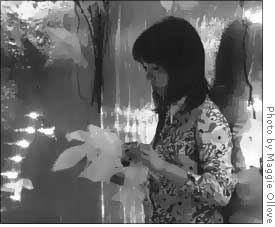
| << Front page | Arts | March 2, 2007 |
Senior Art Shows Alter Viewer's Perception
 |
||
| Dancing Through the Disciplines: Fogel’s piece incorporated visual and physical aspects to engage viewers. | ||
In Silva’s part of the show, the viewer walks into a dark room lit only by three rectangular projections of colored, textured light on three walls. In the center of the space sit several speakers and audio equipment, which fill the space with the sound of dripping water and cave-like echoes. The projections are covered in flowing tulle-like material. The blue and green rhombuses of light are textured by rings of white, like a rippling pool of water or the grain of cut wood.
In the back third of the gallery was Fogel’s show. The work consisted of four walls covered in aluminum foil, AstroTurf carpeting and two long tubes that snaked from the ceiling down to the floor and up again to the opposite corner. From the tubing hangs clear plastic sheeting layered and draped to create a sort of curtained divider within the space.
With the aquatic sounds of Silva’s show in the background, the viewer walks through the narrow passageway created by the plastic sheeting lit by strings of colored and white Christmas lights, which are either coiled on the floor or strung haphazardly on the aluminum walls. The viewer then arrives in a small, open AstroTurf-covered space whose prime visual focus is a small television in the right-hand corner. On the screen a video of the show’s opening performance loops silently.
One can settle in comfortably on the soft faux-grass beside the pile of blinking lights and contentedly watch dance majors on the screen performing in the same space in which one is sitting. The dancers played with the various objects strewn around the space—flowers made of clear plastic sheeting, fake red roses, piles of Christmas lights and various other “found objects.” The dancers on the screen rarely related to one another, except to occasionally drape themselves over one another before splitting apart just as serenely as they had come together.
Silva was not as successful as Fogel in altering the gallery experience for the viewer. The sound and the dimmed lights of Silva’s show did have the effect of disarming and surprising the viewer upon entering the space, but the projections were not especially visually or emotionally compelling; therefore, the overall impact of the experience was weakened.
The large, clunky audiovisual equipment clustered in the center of the room physically prevented me from moving any closer to the projections, had I wanted to do so. I was limited to the outskirts of the space, and so any “environment” that was created simply didn’t let me into it. I felt no connection to the work as a whole and moved easily on from Silva’s portion of the show toward the curiosity of the monstrous plastic and aluminum construction in the back of the gallery.
By creating a smaller, enclosed environment within the larger gallery space, Fogel compelled the viewer’s curiosity and drew him or her in to engage with the piece by entering the space. Fogel created an interesting impediment in an artful construction of plastic tubing and sheeting which prevented the intrepid gallery-goer from seeing the entire exhibit at its entrance and forced him or her to wander blindly inside.
The fake roses and plastic flowers, Christmas lights and snaking tubes of plastic evoked the sense of having arrived late to some sort of whacked-out suburban lawn party. There was a sense of fun and whimsy, but also an eeriness to the work: the viewer was forced to confront his or her solitude in the confines of the small space where the former presence of people was made evident.
The sounds of water droplets and echoing, wavelike noises wafted over the thinly-constructed aluminum walls from Silva’s show work to enhance the sense of loneliness and isolation and enrich the experience.
Fogel’s only shortcoming was that ultimately, it was an aesthetic overload—there were so many disparate and equally stimulating parts to the piece that at some points I felt a need to close my eyes to get some respite from all the stimuli. By throwing so many strong visual elements together in such a small space, I felt as though Fogel detracted from what could have been a far more powerful emotional impact had she exercised a bit more restraint.
As a whole, the show explored the limitations and possibilities of a gallery as a space to experience art. By attempting to radically alter the sensory environment for the viewer in that space, both artists demonstrated the difficulty and ambition of such an endeavor.
About us
Subscriptions
Advertising